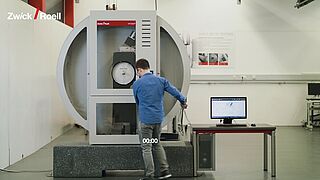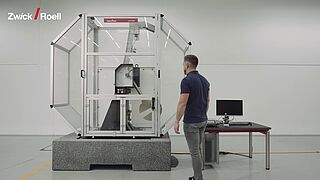- Predominantly metals
- Up to 750 joules
- Charpy
- Izod
- Tensile impact test
- Brugger
- Wedge impact
- ISO 148-1
- ISO 14556
- ISO 11343
- ASTM E23
- BS131-1
- ZF 15-53
- JIS Z 2242
- GOST 9454-78
A pendulum impact testing machine is used to determine the impact strength or toughness of a material under impact loading by measuring the amount of energy the material is able to absorb. Knowing the energy absorption properties of a material is crucial for predicting how much plastic or permanent deformation the material can withstand before it fails. It is therefore an important foundation for decision-making in research and development as well as in quality control and material acceptance.
Technical overview
| Type | HIT450P | HIT300P | |
| Item No. | 1064344 | 1064346 | |
| Rated initial potential energy | 450 | 300 | J |
| Drop height | 1.3969 | 1.3969 | m |
| Impact velocity | 5.23 | 5.23 | m/s |
| Weight | |||
| Without pendulum hammer | 920 | 920 | kg |
| Concrete base | 1600 | 1600 | kg |
| Safety device | 90 | 90 | kg |
| Dimensions, with base | |||
| Height | 2450 | 2450 | mm |
| Width | 2317 | 2317 | mm |
| Depth | 850 | 850 | mm |
| Ambient temperature | +10 ... +35 | +10 ... +35 | °C |
| Temperature during storage and transport | -25 ... +55 | -25 ... +55 | °C |
| Relative humidity (non-condensing) | 20 ... 90 | 20 ... 90 | % |
| Test results, numerical | Impact energy [%], impact energy [J], impact strength [KJ/m2] | ||
| Output units | Analog dial display, digital instrument electronics | ||
| Pulse resolution | 0.036 | 0.036 | ° |
| Interfaces with high-resolution instrument electronics | •Ethernet port to connect a PC •2 x USB port to connect a printer or USB stick or USB Multiplexer •2x RS232 interface | ||
| Power input specifications | |||
| Power supply | 400 | 400 | V, 3Ph/N/PE |
| Permissible voltage fluctuation | ± 10 | ± 10 | % |
| Power consumption (full load), approx. | 1 | 1 | kVA |
| Power frequency | 50/60 | 50/60 | Hz |
| Interfaces | •Ethernet port to connect a PC •2 x USB port to connect a printer or USB stick or USB Multiplexer •2x RS232 interface | ||
| Type | HIT750P | |
| Item No. | 1086220 | |
| Rated initial potential energy | 750 | J |
| Drop height | 1500 | mm |
| Impact velocity | 5.42 | m/s |
| Weight, approx. | ||
| Machine frame () | 510 | kg |
| Safety device | 180 | kg |
| Concrete base | 2520 | kg |
| Total, without pendulum hammer | 3210 | kg |
| Total, testable, incl. Charpy pendulum hammer 750 J | 3300 | kg |
| Dimensions, with concrete base | ||
| Height | 2773 | mm |
| Width | 2556 | mm |
| Depth | 1223 | mm |
| Ambient temperature | +10 ... +35 | °C |
| Temperature during storage and transport | -25 ... +55 | °C |
| Relative humidity (non-condensing) | 20 ... 90 | % |
| Test results, numerical | Impact energy [%], impact energy [J], impact strength [KJ/m2] | |
| Output units | Analog display, digital instrument electronics | |
| Pulse resolution | 0.036 | ° |
| Interfaces with high-resolution instrument electronics | •Ethernet port to connect a PC •2 x USB port to connect a printer or USB stick or USB Multiplexer •2x RS232 interface | |
| Power input specifications | ||
| Power supply | 400 | V, 3Ph/N/PE |
| Permissible voltage fluctuation | ± 10 | % |
| Power consumption (full load), approx. | 1 | kVA |
| Power frequency | 50/60 | Hz |
Pendulum impact testing machines for plastics
With our HIT series pendulum impact testers for tests on plastics up to 50 joules, ZwickRoell offers a particularly precise, while also economical solution for the polymer industry:
- Charpy tests: ISO 179, ASTM D6110
- Izod tests: ISO 180, ASTM D256, ASTM D4812
- Tensile impact tests: ISO 8256 methods A and B, ASTM D1822
- Dynstat bending impact tests: DIN 53435
What is pendulum impact testing?
Pendulum impact testing essentially requires the placement of a specimen in the testing machine, where it is struck with a with a hammer mounted on a swinging pendulum. The base components of a pendulum impact tester are the machine frame, a weighted pendulum rod with hammer, a dial gauge, specimen supports, and a safety shield/device. Complete pendulum impact systems can also include PC equipment and temperature conditioning devices.
- For a Charpy test, the most common pendulum impact test for metals, a metal specimen is machined with a v-shape notch (in special cases, a u-shape notch), which provides a defined breaking point. The specimen is centered on the supports horizontally with the notch facing away from the pendulum. The pendulum is released to strike and fracture the specimen.
- As the specimen is hit, it absorbs part of the kinetic energy. The tougher the material, the more it has to be deformed before it breaks. On the other hand, very brittle specimens break almost without deformation. While influences such as fracture speed and notch shape are an important part of the test, the main purpose of the Charpy pendulum impact test is to qualitatively compare the toughness of the same material at different temperatures.
- By testing identical specimens at varying temperatures, it is possible to determine at what temperature the material becomes brittle, which helps predict its limitations. Consider, for example, the importance of understanding the impact characteristics of the material used to build the body of an airplane and the different temperatures it must sustain on the ground in different climates and as it reaches flight altitudes.
Differentiation between instrumented and non-instrumented testing
Depending on the objective, application and material of the test being performed, pendulum impact tests can be carried out with either conventional or instrumented equipment.
- In a conventional test (not instrumented), the amount of energy absorbed by the specimen during fracture is calculated by comparing the difference of the height of the pendulum before and after the fracture. The energy absorbed is directly related to the brittleness of the material, where brittle materials normally have lower absorption rates than ductile materials.
- An instrumented impact test measures the force during impact, provides high-speed stress/strain data that differentiates between ductile and brittle failure and provides information on fracture mechanical characteristics. Instrumentation, therefore, allows us to determine the failure mode not just the failure energy.






